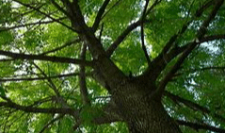Note: Ash/Lilac Borer is a different insect than Emerald Ash Borer. Ash/Lilac Borer has been around for many years while Emerald Ash Borer has a more limited range in eastern Kansas. As far as I know, Emerald Ash Borer has not been confirmed west of the Topeka area.
If you have had problems with canes or stems of lilac and privet suddenly wilting, or ash trees that show borer holes in the trunk and larger branches, the ash/lilac borer may be to blame. This insect causes the base of infested lilac stems to swell and the bark to separate from the wood. A fine sawdust-like material is present around holes in the canes. Ash and mountain ash also are affected. The borer attacks the trunk, which may cause bark to swell and crack if there are repeated infestations.
Ash/lilac borers overwinter as larvae in infested trees and shrubs. Moths generally begin to emerge in mid to late April. Emergence peaks in May, dwindles by mid to late June and ends by the first week of July. However, this varies by year. The moth has clear wings and resembles a wasp. There is one generation per year.
Public and commercially managed properties often use pheromone traps to determine the presence of adults. Spray treatments are started seven to 10 days after capture of the first moths.
Sprays also can be timed using phenology, the practice of timing one event by another. The first spray for ash/lilac borer should be applied when the Vanhoutte spirea is in full to late bloom. This is often about the third week in April but can be as early as late March and as late as mid-May. Apply a second spray four weeks after the first. The Missouri Botanical Garden has several images of Vanhoutte spirea.
Thoroughly treat the trunk and larger limbs of ash or the lower portion of the stems of lilac or privet. Heavily infested ash should be cut and burned during the fall and winter. Infested stems of lilac or privet should be removed as well.
Products with bifenthrin or permethrin (Hi-Yield Garden, Pet, and Livestock Insect Control and 38 Plus Turf, Termite and Ornamental Insect Control) are labeled for control. Though there are a number of homeowner products that contain one or the other of these two active ingredients, the permethrin products listed above are the only ones I’ve found that specifically lists the ash/lilac borer on the label with directions for control.
Ward Upham, Extension Agent

